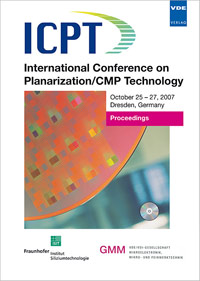Novel slurries for achieving a low silicon dioxide and high silicon nitride removal during chemical-mechanical planarization
Conference: ICPT 2007 - International Conference on Planarization / CMP Technology
10/25/2007 - 10/27/2007 at Dresden, Germany
Proceedings: ICPT 2007
Pages: 6Language: englishTyp: PDF
Personal VDE Members are entitled to a 10% discount on this title
Authors:
Natarajan, A.; Veera, Dandu; Babu, S. V. (Department of Chemical Engineering, Clarkson University, Potsdam, NY 13699, USA)
Babu, S. V. (Center for Advanced Materials Processing, Clarkson University, Potsdam, NY 13699, USA)
Abstract:
Chemical mechanical planarization (CMP) of silicon nitride (Si3N4) films selective to that of silicon dioxide (SiO2) films is both challenging and promising for emerging applications in integrated circuit chip fabrication. In this work, CMP processes yielding a low SiO2 and a relatively high Si3N4 removal have been developed using both zirconia and silica abrasives. Zirconia abrasives yield a removal rate selectivity of Si3N4 over SiO2 that is as high as 78. In contrast, with colloidal silica-based slurries, the highest removal rate selectivity obtained was only ~8. However, the selectivity of the silica-based CMP process was highly tunable, with the Si3N4:SiO2 removal rate selectivity ranging from 1:1 (both at low removal rates of SiO2 and Si3N4 of around 5 or 10 nm/min and at high removal rates of ~60 nm/min) to 8:1. Several factors which enable the CMP of Si3N4 selective to the SiO2 film have also been discussed.


